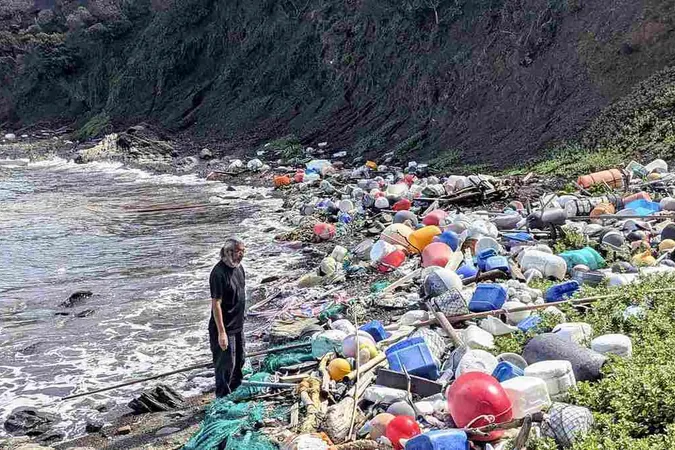
Plastic Waste Crisis: Sea of Japan Suffers Under Asian Debris
2025-08-19
Author: Mei
A Growing Environmental Disaster
The stunning shores of the Sea of Japan are being overwhelmed by an influx of plastic waste from neighboring Asian countries, creating a mounting environmental crisis for the region. Recent intergovernmental talks held in Switzerland aimed to establish the first-ever global treaty to combat pollution, but participants failed to reach a consensus by the August 15 deadline, raising alarms over the urgent need for effective action against plastic pollution.
Japan's Striking Plastic Footprint
In a paradoxical twist, Japan is not only a victim of this environmental calamity but is also one of the largest producers of plastic waste worldwide. Reports indicate that plastic debris, including containers and bottles, is suffocating the western coastline of Tsushima in Nagasaki prefecture, just around 50 kilometers from South Korea’s bustling Busan. Tour guide Shoko Sakata lamented, "No matter how many times we collect them, they keep washing ashore whenever there’s heavy rain or a typhoon."
Staggering Statistics Exposed
The Tsushima region alone grapples with an astounding 30,000 to 40,000 cubic meters of floating refuse each year, with over half being plastic. Shockingly, a staggering 54% of plastic bottles found washed ashore in 2024 originated from China and Taiwan, while 38% came from South Korea. According to the Organisation for Economic Cooperation and Development (OECD), around 20 million tonnes of plastic waste are introduced into the global environment annually, with a vast majority stemming from developing nations suffering from inadequate waste management.
Calls for International Action
To rectify this growing issue, Japan is stepping up efforts by planning to assist its Asian neighbors in establishing improved waste sorting and collection systems. The country aims to train 10,000 personnel dedicated to pressing waste control strategies. Yet, experts underscore that reducing the influx of drifting waste ultimately hinges on the initiatives of the producing nations.
Local Efforts and Initiatives
Mr. Michinao Suenaga, a member of the Tsushima Coast and Aquatic Preservation Programme Association, highlighted the dire need for international regulations, asserting, "International rules are needed to restore clean beaches." Meanwhile, a survey by the Environment Ministry revealed that the majority of plastic bottles found along the coasts of the Pacific and Seto Inland Sea are domestically sourced, attributed to prevailing ocean currents and wind patterns.
Microplastics: An Invisible Threat
As plastic waste degrades under UV rays and wind, it breaks down into microplastics—tiny fragments measuring less than 5 mm—raising health concerns as they potentially enter the food chain through fish consumption. Notably, Japan ranks second only to the United States in per capita plastic packaging waste, producing a staggering 32 kg annually as of 2015.
The Push for Change
Both public and private sectors in Japan are mobilizing to cut down on plastic waste. For instance, Kirin Holdings is championing label-free bottles in a bid to foster a circular economy and diminish environmental impacts. However, the Plastic Resource Circulation Law, effective since 2022, imposes stringent planning requirements for larger businesses while offering little to small operations, leading to varied compliance levels.
Looking Ahead
In closing, a senior Environment Ministry official emphasized ongoing efforts to foster international discussions aimed at treaty development, while promoting effective domestic and international initiatives to combat plastic pollution. With beaches and marine life at risk, the call to action has never been more urgent.
 Brasil (PT)
Brasil (PT)
 Canada (EN)
Canada (EN)
 Chile (ES)
Chile (ES)
 Česko (CS)
Česko (CS)
 대한민국 (KO)
대한민국 (KO)
 España (ES)
España (ES)
 France (FR)
France (FR)
 Hong Kong (EN)
Hong Kong (EN)
 Italia (IT)
Italia (IT)
 日本 (JA)
日本 (JA)
 Magyarország (HU)
Magyarország (HU)
 Norge (NO)
Norge (NO)
 Polska (PL)
Polska (PL)
 Schweiz (DE)
Schweiz (DE)
 Singapore (EN)
Singapore (EN)
 Sverige (SV)
Sverige (SV)
 Suomi (FI)
Suomi (FI)
 Türkiye (TR)
Türkiye (TR)
 الإمارات العربية المتحدة (AR)
الإمارات العربية المتحدة (AR)